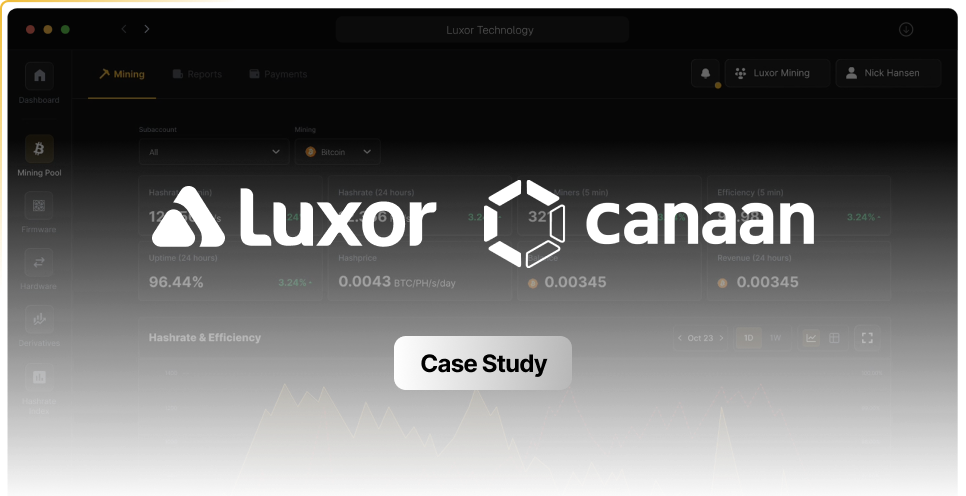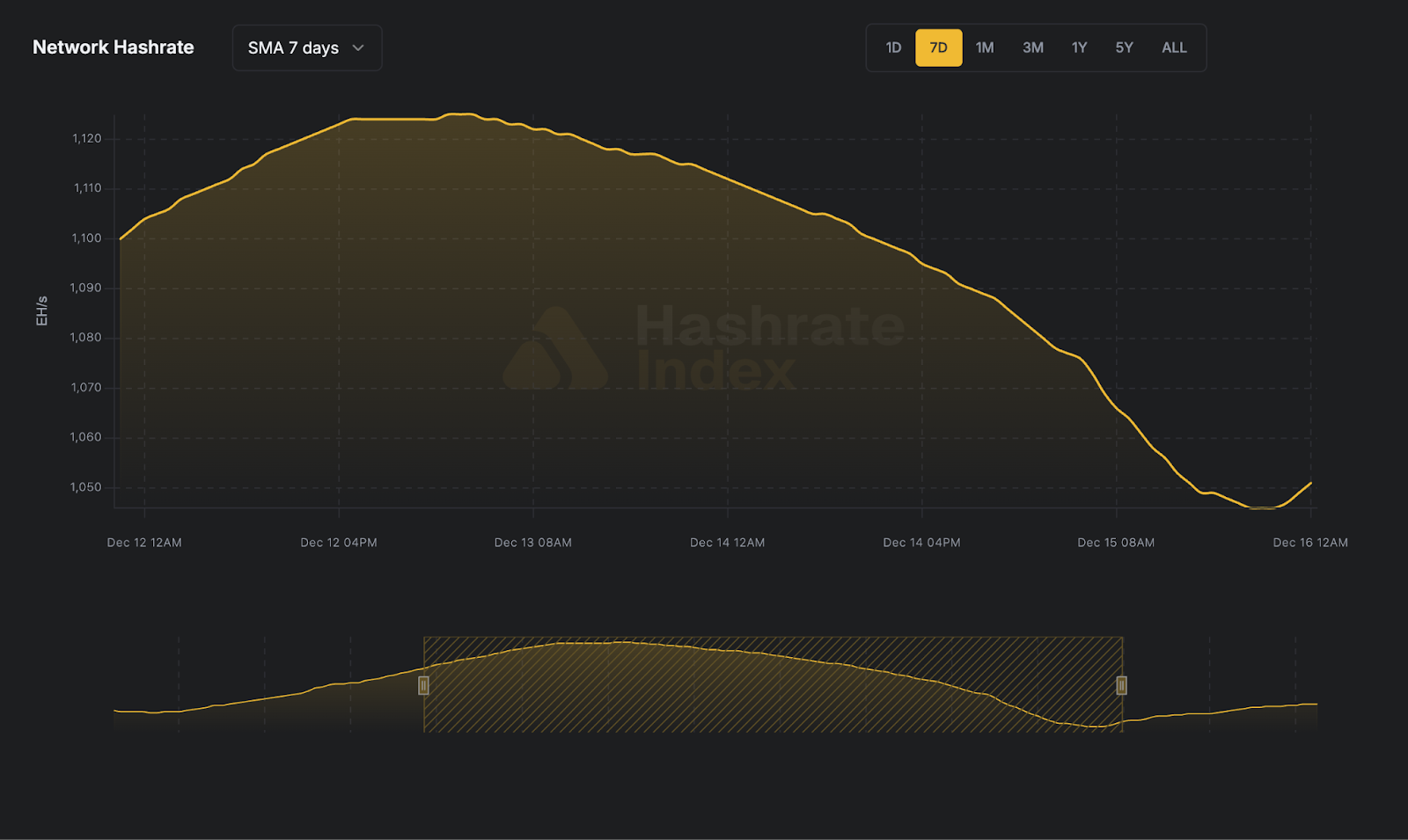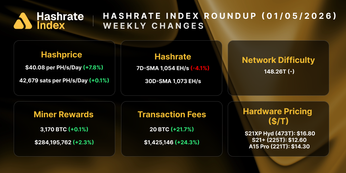
Canaan’s Approach to Full-Stack Mining
A case study on hashprice hedging.
Background: Canaan’s Unique Position in Bitcoin Mining
Canaan (NASDAQ: CAN), a pioneer in Bitcoin mining since 2013, is a leading manufacturer of Bitcoin mining hardware and an experienced operator in the industry. Known for its Avalon Series, the company has a legacy of technical innovation as the first to bring application-specific integrated circuit (ASIC) miners to market, step-changing mining economics by dramatically improving hashrate and energy efficiency over predecessors like GPUs and FPGAs.
However, Canaan is more than just a hardware manufacturer. It is also a vertically integrated Bitcoin miner, running its own self-mining operations alongside its hardware manufacturing business. This gives Canaan a rare and nuanced perspective into the sector, since it faces the same operational and financial risks as its customers.
The Challenge: Managing Operational and Financial Risks
Canaan’s vertically integrated strategy means it benefits from sourcing high-quality machines at cost and securing power at competitive prices, but one key variable remains volatile and unpredictable: hashprice.
To address this, Canaan added a financial layer to its mining stack by integrating with Luxor Pool's fixed and upfront payouts — enabling the company to lock in future revenue, stabilize cash flow, and strengthen its financial position during a turbulent market environment.
Avalon A15 Series: Performance Metrics
In mid-2024, Canaan launched its Avalon A15 Series, expanding its manufacturing footprint to the U.S. from Malaysia and China. This series delivers enhanced performance and energy efficiency across air, immersion, and hydro models.
The air-cooled Avalon A15 machines offer hashrate performance of up to 221 TH/s and energy efficiency ratings as low as 16.8 J/T, depending on the specific model. The table below summarizes performance metrics for the three models (A15, A15 XP, A15 Pro):
As a result of extensive design verification focused on enhancing heat sinks and hashboards, Canaan's Avalon A15’s have been recognized for maintaining consistent performance under challenging thermal conditions. This focus on thermal management makes the series suitable for mining operations in warmer climates, such as Texas, where ambient summer temperatures can frequently surpass 40℃/104℉ and pose significant operational challenges.
Field Feedback
“Between hot environments and frequent curtailment, we demand a lot from our mining equipment, and Canaan has always helped us solve our toughest challenges.” — Tyler Page, CEO of Cipher Mining (NASDAQ: CIFR)
“We deployed the A15 miners at our Texas facility, and their stability is impressive, even under high ambient temperatures reaching 40°C lately.” — Jeff Xu, CEO at Luna Squares Texas
“We have deployed the A15 series miner at our Norcross immersion location, the miners have been tremendous. Very low failure rate, delivered on the specs they advertised, we are very pleased with their performance.” — Taylor Monnig, Chief Technology Officer at CleanSpark (Nasdaq: CLSK)
Over the years, Canaan’s Avalon mining machines earned a reputation for reliability and performance, establishing the manufacturer as a trusted partner for industrial-scale operations worldwide. Today, they are one of the most widely deployed and battle-tested ASIC platforms in the industry.
However, Canaan recognized that although its Avalon A15 hardware was engineered for thermal efficiency, proactive financial risk management was still necessary for its Bitcoin mining stack.
The Value Proposition of Derivatives
Bitcoin miners face a unique set of structural challenges. Unlike many industries, miners operate with highly unpredictable inputs — future revenues are determined by volatile, unpredictable variables like the price of Bitcoin, network difficulty, and transaction fee collection. This makes it exceedingly difficult to predict earnings, budget for capital expenditures, or to plan and execute on an optimal growth strategy. On top of this, miners are faced with an embedded growth obligation in operational hashrate under management (HUM) just to maintain market share, fueling a hardware arms race. Most miners also operate with a relatively inefficient capital stack, relying on expensive debt and dilutive equity to fund growth — an overall combination that leads to volatile earnings, poor visibility, and low valuation multiples.
Fortunately, miners can look to other commodity industries for a time-tested solution. For example, the oil & gas sector faces a similar dynamic: companies make heavy upfront investments to produce a fungible commodity at an uncertain future price. However, oil & gas companies routinely hedge future production through robust derivatives programs, allowing them to lock in revenues, meet cash flow obligations, access cheap(er) capital, and command higher valuations in public markets. Bitcoin miners are increasingly adopting this financial risk management strategy to position themselves for sustainable growth.
We see three core benefits from a miner incorporating hashrate derivatives into its strategy:
1. Business Continuity
Bitcoin’s inherent volatility, coupled with miners’ high operating leverage, has put many operators in financial straits during drawdowns. Hedging with hashrate derivatives helps miners lock in a minimum revenue level by forward-selling all or a portion of future hashrate production. This ensures the ability to meet operating expenses, debt service, and maintenance CapEx under adverse market conditions. A hedged miner is far more likely to remain a going concern through a full cycle.
2. Improved Access to Capital
Hedging doesn’t just protect against downside risk, it actually unlocks growth potential. Lenders and investors prefer to back miners with predictable cash flows, and banks in particular are more willing to extend low-cost loans to miners who have secured forward revenue through hedging. This dynamic allows miners to finance growth through cheap debt rather than costly, dilutive equity or high-interest loans, dramatically improving project economics and returns on investments. By monetizing future earnings through hedges, miners can access capital immediately, enabling fleet expansion and infrastructure investments at lower cost.
3. Higher Valuations
Investors tend to reward companies that deliver not just profitability and growth, but also earnings visibility and stability. In other words, lower earnings volatility can translate to higher valuation multiples. Unfortunately, miners today are penalized with deep uncertainty discounts due to the unpredictable nature of their revenues. By deploying a sound hedging program, industrial miners can materially improve earnings predictability, reduce volatility, and potentially command higher valuations in public markets — closing the gap between perceived risk and underlying fundamentals.
Beyond these core benefits, hashrate derivatives open the door to new strategic financial opportunities. For example, miners can take a step further by pairing a revenue-side hashrate forward sale (i.e., a fixed pool payout rate) with a cost-side power hedge (i.e., a PPA). This approach — referred to as the hashspark spread — is inspired by the natural gas industry’s “spark spread”, which measures the margin between fuel cost and electricity revenue. With a fixed-power price and a fixed pool payout rate, a miner can effectively convert a volatile mining operation into a real-time energy arbitrage business, turning risk management into growth.
Canaan’s Hedging Strategy in Action
In Q2 2025, as network difficulty continued to climb steadily, Canaan entered a forward hashrate sale to hedge a portion of its expected production. The goal wasn’t to speculate, but rather to obtain revenue predictability for capital expense (CapEx) and hardware deployment planning.
Timeline & Mechanics
Canaan entered into a Deliverable Forward (DF) sale in May 2025, locking in an upfront pool payout rate at an agreed hashprice. By selling its hashrate production forward and physically delivering throughout the contract term, Canaan received an upfront BTC payout from Luxor Pool, allowing the company to front-load and monetize its future revenue without disrupting any mining operations or custody arrangements. This strategy offered revenue certainty during a particularly hot and volatile summer.
“Our goal with hashrate forwards isn’t to beat the market. It’s to support growth initiatives.” — Canaan Risk Management Team
In short, Canaan used derivatives not as a speculative tool, but as a means of managing risk, maintaining optionality, and positioning itself to capitalize on future mining market cycles.
- Predictable revenues allowed Canaan to continue investing in hardware and infrastructure.
- By demonstrating predictable cash flows, Canaan strengthened its credit profile, gaining access to more competitive financing and attracting capital on better terms.
- Locking in future revenues provided a cushion against downside risk.
- By preserving operating cash flow during growth, Canaan avoided unnecessary equity issuance, protecting shareholder value.
- As an institutional-facing publicly traded company, hedging aligns Canaan’s practices with corporate governance and risk management best frameworks expected by investors and public markets.
Note: although selling forward may or may not prove to be favorable during different timeframes, it is critical to recognize that hedging typically serves a business continuity purpose rather than revenue generation. Hedgers willingly pay a price to buy certainty and obtain more predictable cash flows, which increases valuation, reduces cost of capital, and ultimately attracts investments.
Conclusion
Canaan’s strategy illustrates the power of pairing operational excellence with financial innovation:
- Avalon A15 Series hardware demonstrates strong thermal performance and high uptime under extreme conditions, proving valuable in heat-prone markets.
- Hashrate forwards offer a range of benefits, helping stabilize cash flows and support growth planning.
Together, this dual approach enabled maximal uptime, predictable margins, and sustainable growth for Canaan, despite external market pressures.
As Bitcoin mining matures, success will favor participants who can optimize both the revenue side and the cost side of the margin equation. Tools like fixed and upfront pool payouts will continue to play a significant role in driving capital efficiency and financial strategy. For operators seeking to outperform in an increasingly competitive environment, proactive hedging is no longer optional — it’s essential.
If you’d like to learn more about Luxor’s Bitcoin mining derivatives, please reach out to [email protected] or visit https://www.luxor.tech/derivatives.
Disclaimer
This content is for informational purposes only, you should not construe any such information or other material as legal, investment, financial, or other advice. Nothing contained in our content constitutes a solicitation, recommendation, endorsement, or offer by Luxor or any of Luxor’s employees to buy or sell any derivatives or other financial instruments in this or in any other jurisdiction in which such solicitation or offer would be unlawful under the derivatives laws of such jurisdiction.
There are risks associated with trading derivatives. Trading in derivatives involves risk of loss, loss of principal is possible.
Hashrate Index Newsletter
Join the newsletter to receive the latest updates in your inbox.









